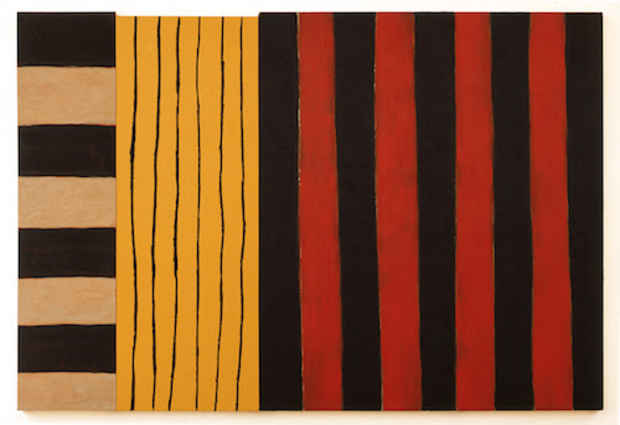Sean Scully “The Eighties”
Mnuchin Gallery

[Image: Sean Scully "By Night and By Day" (1983) oil on canvas, 97 x 141 1/4 in. Courtesy Mnuchin Gallery. Art © Sean Scully.]
This event has ended.
Mnuchin Gallery presents Sean Scully: The Eighties, a solo exhibition of paintings by Sean Scully (b. 1945, Dublin), the globally renowned painter celebrated for his singular, poetic mode of Post-Minimalist abstraction. The exhibition will present a focused look at the pivotal decade of the artist’s career in which he transitioned away from the precisely striped and gridded canvases of his early work into the painterly, multipart constructions that characterize his practice today. This will be the first exhibition in the United States to examine this breakthrough moment in Scully’s oeuvre, tracing his evolution from 1982 through 1989. Organized with the artist, the exhibition will bring together examples from museums and private collections and will be accompanied by a fully-illustrated, hardcover catalogue authored by Deborah Solomon.
Scully began his career as an artist in London in the 1960s and achieved early commercial success in the 1970s with his technically virtuosic paintings of brightly colored, hard-edged bands and lines, inspired by American Minimalism. By 1982—this exhibition’s chronological starting point—Scully had relocated to New York City, where he held a professorship at Parsons School of Art and was living and working on a floor of a former textile factory in Tribeca. It was during this moment that, he explains, “I decided that what had been stripped out of painting—i.e., the ability to make relationships, to be metaphorical and referential, spiritual, poetic, all those things and aspects of human nature—had to be put back in if painting was to go forward.” Using old boards he rescued from his loft’s industrial past, Scully began to create deep, sculptural stretcher frames, painting both the fronts and sides of the resulting object-like canvases. He then combined multiple canvases of varying sizes and depths into single pictures; in his words, “By striping up each panel separately, and forcing them together, I was making romantic portraits of the city: all based on collision, pressure and disharmony.”
In these multipanel constructions, Scully abandons the pure, bright colors of his 1970s paintings in favor of a moodier, more nuanced palette. He replaces the clean, rigid lines of his earlier work with softly overlapping, Rothko-esque layers of pigment, and expressive, varied brushwork. Scully structures his compositions with geometric shapes—rectangles, squares, and checkerboards—reminiscent of architectural motifs, such as doors and windows, bricks and stones. These simplified forms then provide the support for his unabashedly Romantic explorations of color, light, and texture, which are inspired by the artist’s personal experiences of people, places, and emotions. The evocative duality inherent in these works—they are both geometric and gestural, conceptual in their construction and sensual in their tactility—continues to characterize Scully’s painting today.
Despite the prevailing trend of Postmodern figuration during the 1980s, Scully’s new mode of working achieved immediate critical acclaim and international prominence. In 1984, the Museum of Modern Art included him in their International Survey of Recent Painting and Sculpture, and in 1985, the Carnegie Institute in Pittsburgh organized his first major solo exhibition in the United States, which traveled to the Museum of Fine Arts, Boston. That same year, the Metropolitan Museum of Art became the first American museum to acquire his work. The decade culminated with Scully’s first solo exhibition in a European museum when, in 1989, his Whitechapel Art Gallery exhibition traveled to the Palacio Velázquez, Madrid and the Städtische Galerie im Lenbachhaus, Munich.
Today, Scully lives and works in New York. He has been twice shortlisted for the Turner Prize and his work is in the collection of virtually every major museum around the world. In 2014, he became the only Western artist to have had a career-length retrospective exhibition in China (Follow the Heart: The Art of Sean Scully 1964-2014 included over 100 paintings and traveled from Shanghai to Beijing). Continuing his great success in China, Scully is currently the subject of a major solo exhibition at the Art Museum of the Nanjing University of the Arts, which will travel to the Guangdong Museum of Art, Guangzhou and the Hubei Museum of Art, Wuhan. This year, he will also be the subject of solo museum shows in Budweis, Czech Republic; Valencia, Spain; and Garrison, New York.
Sean Scully: The Eighties is being organized with the artist and with the support of his dealers, Timothy Taylor, London; Cheim & Read, New York; and Galerie Lelong, Paris.
Media
Schedule
from September 13, 2016 to October 22, 2016
Opening Reception on 2016-09-13 from 17:30 to 19:30